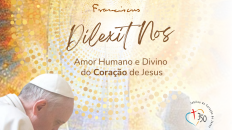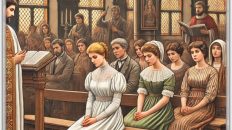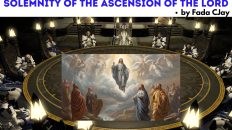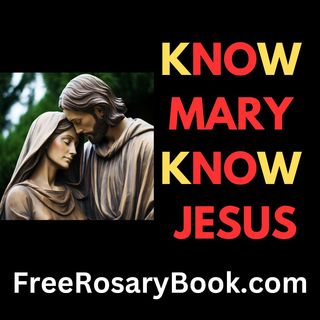Most people are not aware
that the “Catholic Church” is actually comprised of different rites all in union with the pope. The Western, or
Latin Catholic Church, is so large, however, that many people, even Catholics,
are completely unaware of the other twenty-two churches, which make up the
Eastern Branch. (Some have from only a few thousand members to a few million.)
that the “Catholic Church” is actually comprised of different rites all in union with the pope. The Western, or
Latin Catholic Church, is so large, however, that many people, even Catholics,
are completely unaware of the other twenty-two churches, which make up the
Eastern Branch. (Some have from only a few thousand members to a few million.)
First, there is no division or separation between the Latin rite and the more
than 20 Catholic Eastern Churches. There are, however, many differences and
distinctions. These multiple distinctions give each Church its characteristic
identity within the one fold which is the Catholic Church. The most obvious
distinctions are external. Each Church uses a distinct ritual for Mass, the
sacraments and sacramentals.
According to the Catechism of the Catholic Church (CCC), There are two broad
distinctions within the Catholic Church (CCC, 1200-1203):
1. “The Latin Church, most of which is associated with “The Roman Rite. ‘We
call the members of the Roman rite “Roman Catholics.’
2. The Eastern Churches, each of which has its own associated rite, liturgical
language, customs, spirituality, region, patriarch, episcopacy, and particular
name.”
In
a better understanding, let us consider a document of the Second Vatican
Council on – DECREE ON THE CATHOLIC CHURCHES OF THE EASTERN RITE (ORIENTALIUM
ECCLESIARUM), SOLEMNLY PROMULGATED BY HIS HOLINESS
POPE PAUL VI, ON NOVEMBER 21, 1964:
“These individual Churches, whether of the East or the West, although they
differ somewhat among themselves in rite (to use the current phrase), that is,
in liturgy, ecclesiastical discipline, and spiritual heritage, are,
nevertheless, each as much as the others, entrusted to the pastoral government
of the Roman Pontiff, the divinely appointed successor of St. Peter in primacy
over the universal Church. They are consequently of equal dignity, so that none
of them is superior to the others as regards rite and they enjoy the same
rights and are under the same obligations, also in respect of preaching the
Gospel to the whole world (cf. Mark 16, 15) under the guidance of the Roman
Pontiff.”
a better understanding, let us consider a document of the Second Vatican
Council on – DECREE ON THE CATHOLIC CHURCHES OF THE EASTERN RITE (ORIENTALIUM
ECCLESIARUM), SOLEMNLY PROMULGATED BY HIS HOLINESS
POPE PAUL VI, ON NOVEMBER 21, 1964:
“These individual Churches, whether of the East or the West, although they
differ somewhat among themselves in rite (to use the current phrase), that is,
in liturgy, ecclesiastical discipline, and spiritual heritage, are,
nevertheless, each as much as the others, entrusted to the pastoral government
of the Roman Pontiff, the divinely appointed successor of St. Peter in primacy
over the universal Church. They are consequently of equal dignity, so that none
of them is superior to the others as regards rite and they enjoy the same
rights and are under the same obligations, also in respect of preaching the
Gospel to the whole world (cf. Mark 16, 15) under the guidance of the Roman
Pontiff.”
In
other words, Eastern Catholic Churches are self-governing particular churches
in full communion with the Pope. Together with the Latin Church, also known as
the Western Church, they make up the Catholic Church. Liturgies of Eastern
Catholic Churches include the Byzantine, Alexandrian, Antiochian, Armenian and
East Syrian Rites, traditions that are shared with other Eastern Christian
churches with which they were once associated, such as the Eastern Orthodox and
Oriental Orthodox Churches. Although some theological issues divide them from
other Eastern churches, they admit members of the latter churches to the
Eucharist and the other sacraments, as governed by canon law.
As a result of migration, Eastern Catholic Churches have spread from Eastern
Europe, the Middle East, North Africa and India to Western Europe, the Americas
and Oceania where eparchies have been established alongside Latin Church
dioceses.
other words, Eastern Catholic Churches are self-governing particular churches
in full communion with the Pope. Together with the Latin Church, also known as
the Western Church, they make up the Catholic Church. Liturgies of Eastern
Catholic Churches include the Byzantine, Alexandrian, Antiochian, Armenian and
East Syrian Rites, traditions that are shared with other Eastern Christian
churches with which they were once associated, such as the Eastern Orthodox and
Oriental Orthodox Churches. Although some theological issues divide them from
other Eastern churches, they admit members of the latter churches to the
Eucharist and the other sacraments, as governed by canon law.
As a result of migration, Eastern Catholic Churches have spread from Eastern
Europe, the Middle East, North Africa and India to Western Europe, the Americas
and Oceania where eparchies have been established alongside Latin Church
dioceses.
Compared
to the Latin-rite Church, the Eastern-rite Churches differ in their internal
organization. This is evident, for example, in the guiding role of the
patriarch or major archbishop, the means of selecting bishops, and in some
cases the presence of married priests. None of these differences, however,
constitute a separation of faith or of communion with the See of Peter. Because
of this, any Catholic may attend, receive Communion, and fulfill the holy day
precept at any Catholic rite.
to the Latin-rite Church, the Eastern-rite Churches differ in their internal
organization. This is evident, for example, in the guiding role of the
patriarch or major archbishop, the means of selecting bishops, and in some
cases the presence of married priests. None of these differences, however,
constitute a separation of faith or of communion with the See of Peter. Because
of this, any Catholic may attend, receive Communion, and fulfill the holy day
precept at any Catholic rite.
For
those Churches where there is a corresponding Orthodox Church (for example, the
several Byzantine or Melkite Churches, the Coptic, and the Syro-Malankara), an
outsider would be hard-put to distinguish between the two celebrations. One key
difference with the Orthodox: The Eastern-rite Catholics mention the Pope in
the anaphora, or Eucharistic Prayer.
those Churches where there is a corresponding Orthodox Church (for example, the
several Byzantine or Melkite Churches, the Coptic, and the Syro-Malankara), an
outsider would be hard-put to distinguish between the two celebrations. One key
difference with the Orthodox: The Eastern-rite Catholics mention the Pope in
the anaphora, or Eucharistic Prayer.
There
is no formal procedure required before attending, but the ancient principle of
“When in Rome, do as the Romans do” should be diligently applied.
Thus a Latin Catholic who wishes to attend one of these rites should acquaint
himself with the basic practices and demands of the rite and adapt himself
accordingly. For example, most Eastern rites remain standing for most of the
celebration and do not kneel for the consecration; a Latin should respect this
tradition. Some rites have stricter fasting rules before receiving Communion,
and as far as possible a Latin should follow suit. Frequency in attending an
Eastern celebration does not inscribe a Catholic to that rite, just as an
Eastern Catholic who habitually attends the Latin rite does not automatically
become Latin. To formally switch rites in a permanent manner requires a formal
procedure.
is no formal procedure required before attending, but the ancient principle of
“When in Rome, do as the Romans do” should be diligently applied.
Thus a Latin Catholic who wishes to attend one of these rites should acquaint
himself with the basic practices and demands of the rite and adapt himself
accordingly. For example, most Eastern rites remain standing for most of the
celebration and do not kneel for the consecration; a Latin should respect this
tradition. Some rites have stricter fasting rules before receiving Communion,
and as far as possible a Latin should follow suit. Frequency in attending an
Eastern celebration does not inscribe a Catholic to that rite, just as an
Eastern Catholic who habitually attends the Latin rite does not automatically
become Latin. To formally switch rites in a permanent manner requires a formal
procedure.
The
Eastern rite should not be confused with the Orthodox Churches. The question is
somewhat diverse for the case of Orthodox Churches, which are not in full
communion with Rome but which enjoy the apostolic succession and all seven
sacraments. While full communion is lacking, the Catholic Church no longer
considers these Churches as being in a formal schism or as being
excommunicated. From the Catholic standpoint, a member of the faithful who is
unable to attend Mass because there is no Catholic celebration available,
“may”, if he so wishes, attend and receive Communion at an Orthodox Divine
Liturgy. Likewise, an Orthodox Christian in a similar situation is allowed to
receive Communion and some other sacraments in any Catholic rite. Such an
attendance is always optional and is never obligatory, not even in order to
fulfill a festive precept. However, not all Orthodox Churches accept this, and
some take a dim view of any form of intercommunion. Once more it is incumbent
upon Catholics not to impinge on others’ sensibilities and limit themselves to
what is acceptable to each particular Church.
Eastern rite should not be confused with the Orthodox Churches. The question is
somewhat diverse for the case of Orthodox Churches, which are not in full
communion with Rome but which enjoy the apostolic succession and all seven
sacraments. While full communion is lacking, the Catholic Church no longer
considers these Churches as being in a formal schism or as being
excommunicated. From the Catholic standpoint, a member of the faithful who is
unable to attend Mass because there is no Catholic celebration available,
“may”, if he so wishes, attend and receive Communion at an Orthodox Divine
Liturgy. Likewise, an Orthodox Christian in a similar situation is allowed to
receive Communion and some other sacraments in any Catholic rite. Such an
attendance is always optional and is never obligatory, not even in order to
fulfill a festive precept. However, not all Orthodox Churches accept this, and
some take a dim view of any form of intercommunion. Once more it is incumbent
upon Catholics not to impinge on others’ sensibilities and limit themselves to
what is acceptable to each particular Church.
Because we believe in “One, holy, Catholic, and apostolic Church,”
some might object, “There is only one Church, so how can we speak of many
‘Churches?” It’s helpful to consider an analogy used by the Church Fathers:
While there are three distinct Persons who share the One Divine Essence, there
are likewise many autonomous individual Churches that make up the one, holy,
Catholic, and apostolic Church. As it is with the Triune Godhead, we must be
careful not to blur true and important distinctions of the individuals in order
to emphasize their unity.
When Christ founded His Church, He commissioned the apostles to go out into the
world to preach and baptize. Most Catholics are familiar with the founding of
the see of Rome by Peter. The primacy of that Church was sealed with the blood
of Peter and Paul, and the succession of bishops continues to the present day.
What many do not know is that the other apostles themselves founded churches,
and that their own successions of bishops continue as well.
Above all, according to the Constitution on the Church, Lumen Gentium, the
Catholic Church is understood to be “a corporate body of Churches,”
united with the bishop of Rome, who serves as the guardian of unity.



